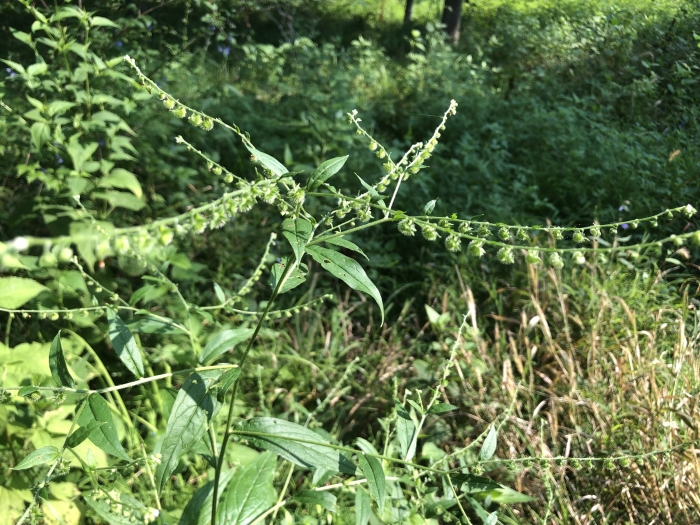Beggarslice
(Hackelia virginiana)
Beggarslice (Hackelia virginiana)
/
/

Daniel S. Katz
CC BY 4.0
Image By:
Daniel S. Katz
Recorded By:
Copyright:
CC BY 4.0
Copyright Notice:
Photo by: Daniel S. Katz | License Type: CC BY 4.0 | License URL: http://creativecommons.org/licenses/by/4.0/ | Rights Holder: Daniel S. Katz | Publisher: iNaturalist | Date Created: 2021-08-07T09:23:10Z |





















































Estimated Native Range
Summary
Hackelia virginiana, commonly known as Beggarslice, is an annual or biennial herb native to open woodlands and forest edges in the eastern half of the USA. It typically grows to a height of 2-3 feet (0.6-0.9 meters) and a width of 2-4 feet (0.6-1.2 meters). The plant features a basal rosette of dark green, irregularly shaped leaves during its first year, with a flowering stalk ascending in the second year. Small, white flowers bloom in mid to late summer, and although not particularly showy, they add a delicate texture to the plant’s profile. The seeds develop into burs that are notably sticky, aiding in seed dispersal when they attach to clothing or animal fur.
Beggarslice is valued for its ability to thrive in shaded conditions, making it suitable for woodland gardens and shaded borders. It is also used in restoration projects due to its native status and the role it plays in supporting local ecosystems. The plant prefers part shade to full shade, low to medium water, and soils with medium drainage. While it is not typically grown for its ornamental qualities, its foliage can provide a lush ground cover in appropriate settings. Gardeners should be aware of its seeding mechanism, as the burs can be a nuisance. The brittle nature of the seeding stems can lead to unwanted seed dispersal if not managed properly.CC BY-SA 4.0
Beggarslice is valued for its ability to thrive in shaded conditions, making it suitable for woodland gardens and shaded borders. It is also used in restoration projects due to its native status and the role it plays in supporting local ecosystems. The plant prefers part shade to full shade, low to medium water, and soils with medium drainage. While it is not typically grown for its ornamental qualities, its foliage can provide a lush ground cover in appropriate settings. Gardeners should be aware of its seeding mechanism, as the burs can be a nuisance. The brittle nature of the seeding stems can lead to unwanted seed dispersal if not managed properly.CC BY-SA 4.0
Plant Description
- Plant Type: Herb
- Height: 1.5-2.5 feet
- Width: 1.5-4 feet
- Growth Rate: Moderate
- Flower Color: White
- Flowering Season: Summer
- Leaf Retention: Deciduous
Growth Requirements
- Sun: Part Shade, Full Shade
- Water: Low, Medium
- Drainage: Medium
Common Uses
Bird Garden, Butterfly Garden, Low Maintenance
Natural Habitat
native to open woodlands and forest edges in the eastern half of the USA
Other Names
Common Names: Beggar’s Lice, Stickseed, Virginia Stickseed, Beggar’s-Lice, Sticktight, Bardanette De Virginie, Hackélia De Virginie, Hackélie De Virginie
Scientific Names: , Hackelia virginiana, Myosotis virginiana, Echinospermum virginicum, Cynoglossum morisonii, Lappula virginiana, Echinospermum virginianum, Cynoglossospermum virginianum, Cynoglossospermum virginicum, Pulmonaria elliptica
GBIF Accepted Name: Hackelia virginiana (L.) I.M.Johnst.